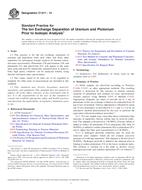We need your consent to use the individual data so that you can see information about your interests, among other things. Click "OK" to give your consent.
ASTM C1411-14
Standard Practice for The Ion Exchange Separation of Uranium and Plutonium Prior to Isotopic Analysis
STANDARD published on 1.1.2014
The information about the standard:
Designation standards: ASTM C1411-14
Note: WITHDRAWN
Publication date standards: 1.1.2014
SKU: NS-11134
The number of pages: 4
Approximate weight : 12 g (0.03 lbs)
Country: American technical standard
Category: Technical standards ASTM
The category - similar standards:
Annotation of standard text ASTM C1411-14 :
Keywords:
ion exchange, mass spectrometry, plutonium, plutonium isotopic analysis, thermal ionization mass spectrometry, uranium, uranium isotopic analysis, ICS Number Code 27.120.30 (Fissile materials and nuclear fuel technology)
Additional information
| Significance and Use | ||||||||||||||||
|
5.1 Uranium and plutonium are used in nuclear reactor fuel and must be analyzed to insure that they meet certain criteria for isotopic composition as described in Specification C833 and Specification C1008. This standard practice is used to chemically separate the same mass peak interferences from uranium and plutonium and from other impurities prior to isotopic abundance determination by thermal ionization mass spectrometry. 5.2 In those facilities where perchloric acid use is tolerated, the separation in Test Method C698 may be used prior to isotopic abundance determination. Uranium and plutonium concentrations as well as isotopic abundances using thermal ionization mass spectrometry can be determined using this separation and following Test Method C1625. |
||||||||||||||||
| 1. Scope | ||||||||||||||||
|
1.1 This practice is for the ion exchange separation of uranium and plutonium from each other and from other impurities for subsequent isotopic analysis by thermal ionization mass spectrometry. Plutonium–238 and uranium–238, and plutonium–241 and americium–241, will appear as the same mass peak and must be chemically separated prior to analysis. Only high purity solutions can be analyzed reliably using thermal ionization mass spectrometry. 1.2 The values stated in SI units are to be regarded as standard. No other units of measurement are included in this standard. 1.3 This standard may involve hazardous material, operations, and equipment. This standard does not purport to address all of the safety concerns, if any, associated with its use. It is the responsibility of the user of this standard to consult and establish appropriate safety and health practices and determine the applicability of regulatory limitations prior to use. |
||||||||||||||||
| 2. Referenced Documents | ||||||||||||||||
|
Similar standards:
Historical
1.1.2013
Historical
1.1.2013
Historical
1.6.2011
Historical
1.6.2012
Historical
1.11.2011
Historical
1.1.2010
We recommend:
Technical standards updating
Do you want to make sure you use only the valid technical standards?
We can offer you a solution which will provide you a monthly overview concerning the updating of standards which you use.
Would you like to know more? Look at this page.



 ASTM E264-08(2013)..
ASTM E264-08(2013).. ASTM E265-07(2013)..
ASTM E265-07(2013).. ASTM E266-11
ASTM E266-11 ASTM E321-96(2012)..
ASTM E321-96(2012).. ASTM E385-11
ASTM E385-11 ASTM E481-10
ASTM E481-10
 Cookies
Cookies
